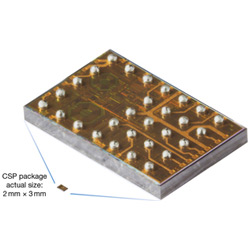
Microsemi has introduced the ZL70550, a new ultra-low-power sub-GHz radio frequency (RF) transceiver for industrial, security and medical applications.
In addition to its best-in-class low power consumption features, the new ZL70550 also has high-performance wireless capabilities, high integration, a very small footprint, and a competitive price. The ZL70550 is ideal for wireless applications running on coin-cell batteries or energy harvesters, such as electronic shelf labels, retail asset tracking, process control, wearable monitoring, medical diagnostics, and ECG.
According to recent market research by On World Inc., by 2015, the chipset's annual sales will reach 450 million pieces, and the wireless sensor market is experiencing "high-speed growth." The company said that although this market is dominated by Wi-Fi, Bluetooth and Zigbee solutions, many applications require much lower power characteristics to run on very small batteries for many years.
Francois Pelletier, director of Microsemi's product line, said: "In many medical and industrial customer applications, battery replacement is a complex and expensive operation that often exceeds the cost of the system itself." The same intellectual property of hearing aids and hearing aids allows us to provide the lowest power wireless link in an extremely small form factor that is easy to deploy without affecting power consumption. "
The ZL70550 operates in the unlicensed industrial, scientific, and medical (ISM) band of 779-965 megahertz (MHz) and consumes only 2.8 milliamps (mA) of power, while transmitting power of -10 dB-milliwatts (dBm) The output during this period is similar to the 2.5 mA reception. It provides the industry's lowest sleep current of 10 nanoamperes (nA), making it ideal for low duty cycle applications. As a flexible solution that can be tailored to the needs of various applications, the ZL70550 operates between 1.7V (V) and 3.6V and provides variable output power and data rates up to 200 kbps. For applications requiring extended wireless range, the transmitter output power, receiver input sensitivity, and data rate can be adjusted to provide a link budget of up to -107 dBm while minimizing the increase in power consumption of the device.
"Working with the Microsemi team to apply its ZL70550 to our medical devices has been groundbreaking because of its ultra-low power consumption, RF input sensitivity and small size provide the best solution for our specific needs," said the The company's vice president of product development, John Walmsley, said. "We are leveraging the unique capabilities of the solution to ensure the successful deployment of our latest innovations, and we look forward to the future development of Microsemi as Starfish Medical will continue to create breakthrough products for many medical specialty areas."
The ZL70550 is highly integrated and is available in an ultra-small chip-scale package of 3mm x 2mm. With the exception of the antenna and in some cases the matching network, only one crystal, resistor and two coupling capacitors are required.
The device includes an advanced media access controller (MAC) that performs most of the link support functions, received signal strength indication (RSSI), net channel assessment, sniffing, preamble and synchronization, packetization, whitening, and pre Directional Error Correction (FEC). Microsemi's optional Z-Star protocol enables rapid product development and offers an all-star configuration to allow deployment of complete networks.
In addition, Microsemi offers wireless sensor network (WSN) evaluation kits and application development kits (ADKs) to simplify and accelerate hardware and software development. The evaluation kit includes a USB hub and an acceleration sensor node, and demonstrates a wireless sensor network application using the ZL70550's built-in Z-Star protocol. ADK provides all the necessary hardware and software to demonstrate the performance of the ZL70550 and is intended to be used as a tool to support prototyping.
 0
0












 Login/Register
Login/Register
 BOM
BOM
 Cart
Cart

